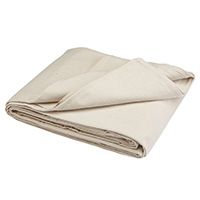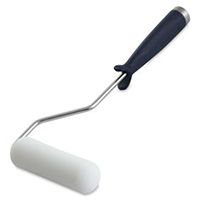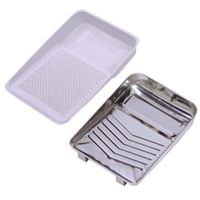We may be compensated if you purchase through links on our website. Our team is committed to delivering honest, objective, and independent reviews on home products and services.
Project details
Skill
Cost
Estimated Time
Painting a nursery in preparation for a new baby can be a breeze if you properly prepare the room and secure safe, non-toxic paint. Choosing the right colors, finishes, and painting techniques should be an exciting process, not a headache. Read our guide on how to easily paint a nursery below, which includes tips on testing for lead, preparing the walls, and protecting the room.
Recommended Tools
Below are some of the tools helpful for painting a nursery.
Choosing the Right Paint for a Nursery
Picking the right paint is one of the most important parts of keeping your baby safe in the new nursery.
Zero VOC Paint
Use zero VOC (volatile organic compounds) paint when painting a nursery. Zero VOC paint does not release harmful chemicals into the air as it dries, and has no odor, which makes it safe for you and your baby.
Paint Finish
The paint finish you choose changes the look of the room and how easy it is to clean. Consider the options below.
- Eggshell: Has a soft shine and is easy to clean
- Satin: Shinier than eggshell, resists wear, and is easy to wipe down
- Semi-gloss: Shiniest of the three, long-lasting, and low maintenance.
Color Selection
There are several variables to consider when choosing the right color for your nursery, including those below.
- Light: Consider how the room looks in natural light.
- Mood: Pick colors that soothe and relax, such as soft, pastel blues and greens.
- Theme: Make sure the color you choose complements any theme you have planned for the room.
Prepare the Room for Painting
Fully prepare your walls for the painting job by following the steps below.
Test for Lead Paint
If your house was built before 1978, you need to test for lead paint, which is especially dangerous to children. Below is the proper testing method:
- Buy a lead paint testing kit: These are available at home centers or hardware stores.
- Follow the instructions: Properly test the walls and trim as directed.
- Talk to a professional: If you detect lead, call an expert.
Protect the Room
Follow the steps below to keep the room clean while painting.
- Protect the floor: Place drop cloths on the floor to catch paint drips.
- Remove or cover furniture: Use drop cloths to protect furniture from paint splatters.
- Use painter’s tape: Apply tape to trim, windows, and outlets to achieve clean edges.
Prep the Walls
Prepare your walls for a lasting paint job by following the steps below.
- Clean the walls: Use a damp cloth to remove dust or debris. Clean walls will help the paint to stick more successfully and reduce peeling and uneven coverage.
- Fill cracks and holes: Apply spackling compound and smooth it out with a putty knife.
- Sand the walls: Lightly sand the walls to create a smooth surface for painting.
Painting Techniques for a Nursery
Once you’ve prepared the room and chosen your paint, you can start painting. Follow the techniques below.
Cutting In
Cutting in involves painting the edges of the wall where it meets the ceiling, trim, and corners. Follow the steps below for a professional finish:
- Angle the brush: Carefully paint along the edges to maintain straight lines.
- Don’t overload your brush: Avoid using too much paint to prevent drips.
- Use a 2-Inch angled brush: This brush offers the user control and precision.
Rolling the Walls
Once you’re done cutting in, use a roller to paint the main areas of the walls. Follow the steps below for proper use:
- Pour paint into a paint tray: Make sure the tray surface is clean.
- Load the roller evenly: Roll it until you’re ready to apply an even coat.
- Start at the top: Roll down the wall in long, even strokes.
- Overlap slightly: Achieve even coverage by overlapping each stroke.
Applying Multiple Coats
Wait for the first coat to dry for about an hour. Apply a second coat using the same techniques you used to apply the first, and consider a third coat if you still need additional coverage.
Wrap It Up
Peel back the tape that lines the trim while the paint is still wet. Once the paint has dried, clean up your drop cloth and use hot, soapy water to clean your brushes. Check out our guide for more tips on how to properly clean up after a painting project.
More Tips for a Perfect Nursery Paint Job
Read the tips below to help you extend the life of your paint job.
Choose the Right Tools
Investing in the quality tools below can help you to achieve professional-looking walls:
- Edging tools: Use these to get neat edges without lots of tape.
- Extension poles: Use these to reach high spots without ladders.
- High-quality brushes and rollers: High-quality tools give you an especially smooth finish.
Mix Paint Cans
If you need to use two or more cans to finish your project, combine them in a larger bucket. This process is called “boxing,” and keeps the color consistent through the room. Even small differences between cans can show up on your walls.
Prime the Walls
Primer can improve your paint job, especially if the walls are stained or darkly colored, or you’re painting over a glossy finish.
Maintain a Wet Edge
Paint in long, continuous strokes to maintain a wet edge and avoid lap marks, which appear when one section of paint dries before you paint the next section.
Safety Considerations When Painting a Nursery
Make safety your top priority when painting a nursery. Follow the tips below.
Ventilation
Good airflow dispels paint fumes quickly and keeps your lungs safe. Use fans, open windows and doors, and consider an air purifier to usher fumes out.
Personal Protection
Protect yourself while painting by wearing old clothes or coveralls, safety glasses, and a respirator mask. A mask is especially important if you’re sensitive to paint fumes, or the room isn’t well-ventilated.
Timing
Schedule your painting project with your baby’s arrival in mind. Finish painting at least two months before the due date, and allow time for the paint to cure. Fresh paint must be completely dry for the smell to dissipate.
Choosing Safe Materials
Invest in zero VOC paint, non-toxic cleaners, and natural fiber drop cloths for the painting process. The cleaners will allow you to prepare the walls without the use of harsh chemicals, and natural drop cloths are safer than plastic sheeting.





